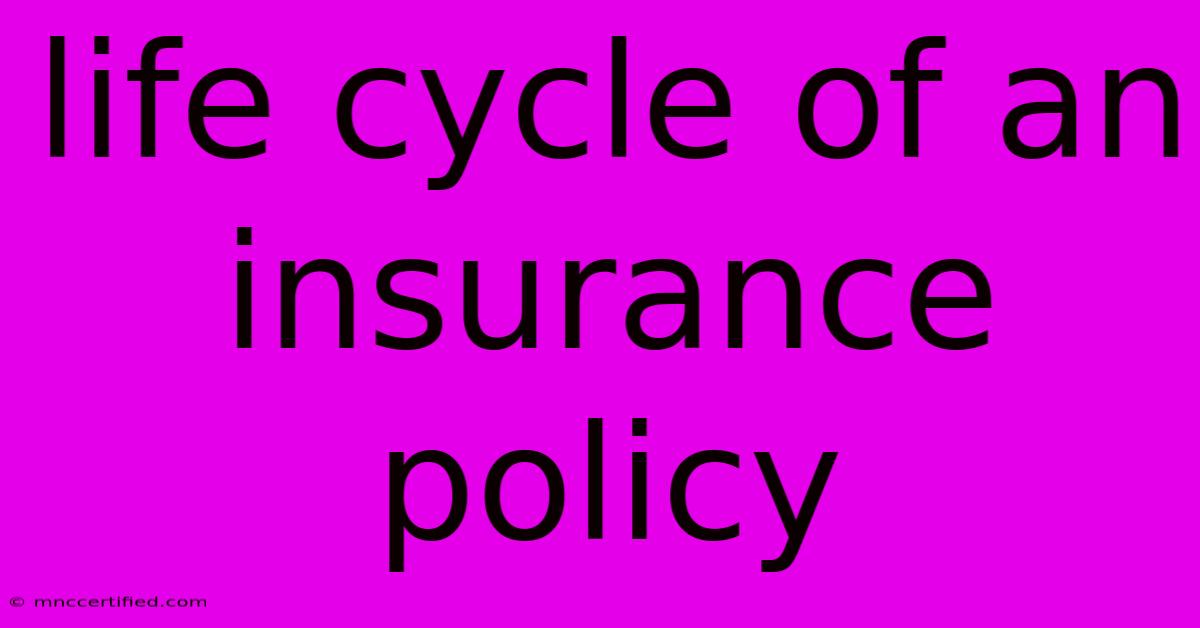Life Cycle Of An Insurance Policy

Table of Contents
The Complete Guide to the Life Cycle of an Insurance Policy
Understanding the life cycle of an insurance policy is crucial for both policyholders and insurance professionals. This comprehensive guide breaks down each stage, from initial application to eventual expiration or cancellation, ensuring you're well-informed throughout the process. We'll cover key aspects and offer advice to navigate each phase effectively.
Phase 1: Application and Underwriting
This initial phase sets the foundation for your insurance coverage. It involves several key steps:
1.1. Application Process:
- Information Gathering: The process begins with completing an application form, providing accurate and comprehensive personal and risk-related information. This includes details about your health (for health insurance), driving history (for auto insurance), property details (for home insurance), and more. Accuracy is paramount as misrepresentation can lead to policy denial or even cancellation later on.
- Supporting Documentation: You might need to provide supporting documentation, such as medical records, driving licenses, or property valuations, to verify the information provided in your application.
- Premium Calculation: Based on your risk profile, the insurer calculates your premium – the amount you'll pay for coverage. Factors like age, location, and health status significantly influence premium calculations.
1.2. Underwriting Process:
- Risk Assessment: The insurer's underwriters assess the risks associated with insuring you. They carefully review your application and supporting documentation to determine your eligibility and the appropriate premium.
- Policy Issuance: If approved, the insurer issues your insurance policy. This legally binding document outlines your coverage, terms, conditions, and exclusions. Read this document carefully!
Phase 2: Policy In-Force
This is the active period of your insurance policy, where you're covered for the specified risks.
2.1. Premium Payments:
- On-Time Payments: Promptly paying your premiums is essential to maintain continuous coverage. Late payments can lead to penalties, suspension, or even cancellation of your policy. Set up automatic payments to avoid missed deadlines.
- Premium Adjustments: Your premium might change over time, depending on factors like changes in your risk profile or market conditions. Your insurer will notify you of any premium adjustments.
2.2. Claims Process:
- Filing a Claim: If you experience a covered event (accident, illness, property damage, etc.), you need to file a claim with your insurer. This usually involves providing detailed information about the incident and supporting documentation.
- Claim Investigation: The insurer will investigate your claim to verify the validity and extent of the damages or losses.
- Claim Settlement: Once the investigation is complete, the insurer will process your claim and pay the benefits as outlined in your policy. This could involve direct payment to you, a healthcare provider, or a repair shop.
2.3. Policy Renewals:
Most insurance policies are renewable. Before the expiration date, you'll receive a renewal notice from your insurer. Review the terms and conditions, and ensure that the coverage still meets your needs. You may have the option to make changes to your policy at renewal.
Phase 3: Policy Termination
This phase marks the end of your insurance coverage.
3.1. Policy Expiration:
Your policy will expire on a specified date. If you choose not to renew, your coverage ends on that date.
3.2. Policy Cancellation:
You or your insurer may cancel the policy before the expiration date. Reasons for cancellation could include non-payment of premiums, material misrepresentation on the application, or changes in your risk profile.
3.3. Policy Lapse:
A policy lapses when you fail to pay premiums and coverage is terminated. Reinstatement might be possible, depending on the insurer's policies and the length of the lapse.
Key Considerations Throughout the Life Cycle:
- Review Your Policy Regularly: Understand your coverage, terms, and conditions. Don't hesitate to contact your insurer if you have any questions.
- Maintain Accurate Information: Notify your insurer of any changes in your circumstances that might affect your coverage (address change, change in family status, etc.).
- Shop Around: Periodically compare insurance policies from different providers to ensure you're getting the best value for your money.
By understanding the life cycle of an insurance policy, you can better manage your coverage, avoid costly mistakes, and ensure you're protected when you need it most. Remember, proactive engagement with your insurer is key to a smooth and successful insurance experience.

Thank you for visiting our website wich cover about Life Cycle Of An Insurance Policy. We hope the information provided has been useful to you. Feel free to contact us if you have any questions or need further assistance. See you next time and dont miss to bookmark.
Featured Posts
-
Kremlin Us Enabling Ukraine Attacks
Nov 19, 2024
-
San Marino Vs Liechtenstein Match Preview
Nov 19, 2024
-
Coleen Rooneys Health Court Case Link
Nov 19, 2024
-
No Ronaldo Portugal Squad Selection
Nov 19, 2024
-
How Carr Shaped The Fcc Under Trump
Nov 19, 2024